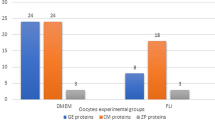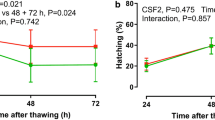Abstract
Cryopreservation of gametes and embryos is widely used for mammalian genome resource banking. Effects of insulin-like growth factor-1 (IGF-1) on the in vitro development of cleavage stage CD1 mouse embryos after their cryopreservation were studied. The mouse embryos developed in vivo up to the 4–6-cell stage were frozen in a programmable freezer according to standard protocol with 10% propylene glycol as a cryoprotectant and thereafter were thawed and cultured in vitro in KSOM for 48 h. The percentage of embryos developed up to blastocyst stage in culture medium supplemented with IGF-1 (40 ng/mL) was higher as compared to controls (78.9 and 47.4%, respectively, p < 0.01). Moreover, blastocysts developed in the presence of IGF-1 contained more cells as compared to controls (79.8 ± 3.9 and 58.6 ± 3.6 cells, respectively, p < 0.001). However, the index of nuclear fragmentation did not differ between these groups. Experimental results presented here revealed the stimulating effects of IGF-1 on the mouse preimplantation embryos after their cryopreservation.

Similar content being viewed by others
REFERENCES
Agca, Y., Genome resource banking of biomedically important laboratory animals, Theriogenology, 2012, vol. 78, pp. 1653–1665.
Aguilar, J.J. and Reyley, M., The uterine tubal fluid: secretion, composition and biological effects, Anim. Reprod., 2005, vol. 2, no. 2, pp. 91–105.
Amstislavsky, S., Brusentsev, E., Kizilova, E., et al., Embryo cryopreservation and in vitro culture of preimplantation embryos in Campbell’s hamster (Phodopus campbelli), Theriogenology, 2015, vol. 83, pp. 1056–1063.
Bowman, P. and McLaren, A., Cleavage rate of mouse embryos in vivo and in vitro, J. Embryol. Exp. Morphol., 1970, vol. 24, no. 1, pp. 203–207.
Brusentsev, E.Y., Igonina, T.N., and Amstislavsky, S.Y., Traditional and modern approaches to culture of preimplantation mammalian embryos in vitro, Russ. J. Dev. Biol., 2014, vol. 45, pp. 53–65. https://doi.org/10.1134/S1062360414020039
Brusentsev, E.Yu., Igonina, T.N., Rozhkova, I.N., Ragaeva, D.S., and Amstislavsky, S.Ya., The effects of growth factors during in vitro cultivation of mouse and rat embryos, Vavilov. Zh. Genet. Selekts., 2015, vol. 19, no. 4, pp. 372–377.
Chen, P., Pan, Y., Cui, Y., et al., Insulin-like growth factor I enhances the developmental competence of yak embryos by modulating aquaporin 3, Reprod. Domest. Anim., 2017, vol. 52, no. 5, pp. 825–835.
Copp, A.J., Interaction between inner cell mass and trophectoderm of the mouse blastocyst. II. The fate of the polar trophectoderm, J. Embryol. Exp. Morphol., 1979, vol. 51, pp. 109–120.
Desai, N., Lawson, J., and Goldfarb, J., Assessment of growth factor effects on post-thaw development of cryopreserved mouse morulae to the blastocyst stage. Hum. Reprod, 2000, vol. 15, no. 2, pp. 410–418.
Desai, N., Kattal, N., Abdel Hafez, F.F., Szeptycki-Lawson, J., and Goldfarb, J., Granulocyte-macrophage colony stimulating factor (GM-CSF) and co-culture can affect post-thaw development and apoptosis in cryopreserved embryos, J. Assist. Reprod. Genet., 2007, vol. 24, no. 6, pp. 215–222.
Handyside, A.H. and Susan, H., Cell division and death in the mouse blastocyst before implantation, Roux. Arch. Dev. Biol., 1986, vol. 195, no. 8, pp. 519–526.
Heyner, S., Smith, R.M., and Schultz, G.A., Temporally regulated expression of insulin and insulin-like growth factors and their receptors in early mammalian development, Bioessays, 1989, vol. 11, no. 6, pp. 171–176.
Igonina, T.N., Brusentsev, E.Yu., Rozhkova, I.N., Naprimerov, V.A., and Amstislavskii, S.Ya., Comparison of various combinations of cryoprotectants and thawing methods for cryopreservation of mouse and rat embryos, Vavilov. Zh. Genet. Selekts., 2015, vol. 19, no. 4, pp. 77–81.
Igonina, T.N., Ragaeva, D.S., Petrova, O.M., et al., Effects of in vitro culture at the preimplantation embryo stage on early development and hypertension in ISIAH rats, Hypertens. Pregnancy, 2019, pp. 1–9.
Kawamura, K., Chen, Y., Shu, Y., et al., Promotion of human early embryonic development and blastocyst outgrowth in vitro using autocrine/paracrine growth factors, PLoS One, 2012, vol. 7, no. 11. e49328.
Khatir, H., Anouassi, A., and Tibary, A., In vitro and in vivo developmental competence of dromedary (Camelus dromedarius) embryos produced in vitro using two culture systems (mKSOMaa and oviductal cells), Reprod. Domest. Anim., 2005, vol. 40, no. 3, pp. 245–249.
Lin, T.-C., Yen, J.-M., Gong, K.-B., Hsu, T.-T., and Chen, L.-R., IGF-1/IGFBP-1 increases blastocyst formation and total blastocyst cell number in mouse embryo culture and facilitates the establishment of a stem-cell line, BMC Cell Biol., 2003, vol. 4, p. 14.
Neira, J.A., Tainturier, D., Pena, M.A., and Martal, J., Effect of the association of IGF-I, IGF-II, bFGF, TGF-beta1, GM-CSF, and LIF on the development of bovine embryos produced in vitro, Theriogenology, 2010, vol. 73, no. 5, pp. 595–604.
Sirisathien, S. and Brackett, B.G., TUNEL analyses of bovine blastocysts after culture with EGF and IGF-I, Mol. Reprod. Dev., 2003, vol. 65, no. 1, pp. 51–56.
Velazquez, M.A., Zaraza, J., Oropeza, A., Webb, R., and Niemann, H., The role of IGF1 in the in vivo production of bovine embryos from superovulated donors, Reproduction, 2009, vol. 137, no. 2, pp. 161–180.
ACKNOWLEDGMENTS
We are grateful to the Center for Collective Use Genetic Resources of Laboratory Animals (http://spf.bionet.nsc.ru) and the Center for Collective Use Microscopic Analysis of Biological Objects (Institute of Cytology and Genetics, Siberian Branch, Russian Academy of Sciences) (http://www.bionet.nsc.ru/microscopy).
Funding
This work was supported by the Russian Foundation for Basic Research (no. 19-016-00025, budget project no. 0324-2019-0041-C-01) using the equipment of the Center for Genetic Resources of Laboratory Animals, Federal Research Center (Institute of Cytology and Genetics, Siberian Branch, Russian Academy of Sciences) and supported by the Ministry of Education and Science of Russia (Unique project identifier RFMEFI62119X0023).
Author information
Authors and Affiliations
Corresponding author
Ethics declarations
COMPLIANCE WITH ETHICAL STANDARDS
Conflict of interest. The authors declare that they have no conflict of interests.
Statement on the welfare of animals. When performing this study, all manipulations carried out with experimental animals, methods of anesthesia, euthanasia and animal care before and after experimental interventions were in accordance with international bioethics standards.
AUTHOR CONTRIBUTION INFORMATION
E.Yu. Brusentsev, T.N. Igonina, and S.Ya. Amstislavsky came up with and developed an experiment design. E.Yu. Brusentsev, T.N. Igonina, and S.V. Ranneva received preimplantation embryos, carried out their freezing-thawing, and their cultivation in vitro. E.A. Kizilova performed DAPI staining, counting the number of interphase nuclei, their fragments and metaphase plates in develo** blastocysts. E.Yu. Brusentsev, T.N. Igonina, S.V. Ranneva, and S.Ya. Amstislavsky participated in data processing. E.Yu. Brusentsev, T.N. Igonina, and S.Ya. Amstislavsky participated in writing the text of the article. All authors participated in the discussion of the results.
Rights and permissions
About this article
Cite this article
Brusentsev, E.Y., Kizilova, E.A., Igonina, T.N. et al. Effects of Insulin-Like Growth Factor 1 on the In Vitro Development of Mouse Embryos after Cryopreservation. Russ J Dev Biol 52, 120–124 (2021). https://doi.org/10.1134/S1062360421020028
Received:
Revised:
Accepted:
Published:
Issue Date:
DOI: https://doi.org/10.1134/S1062360421020028




